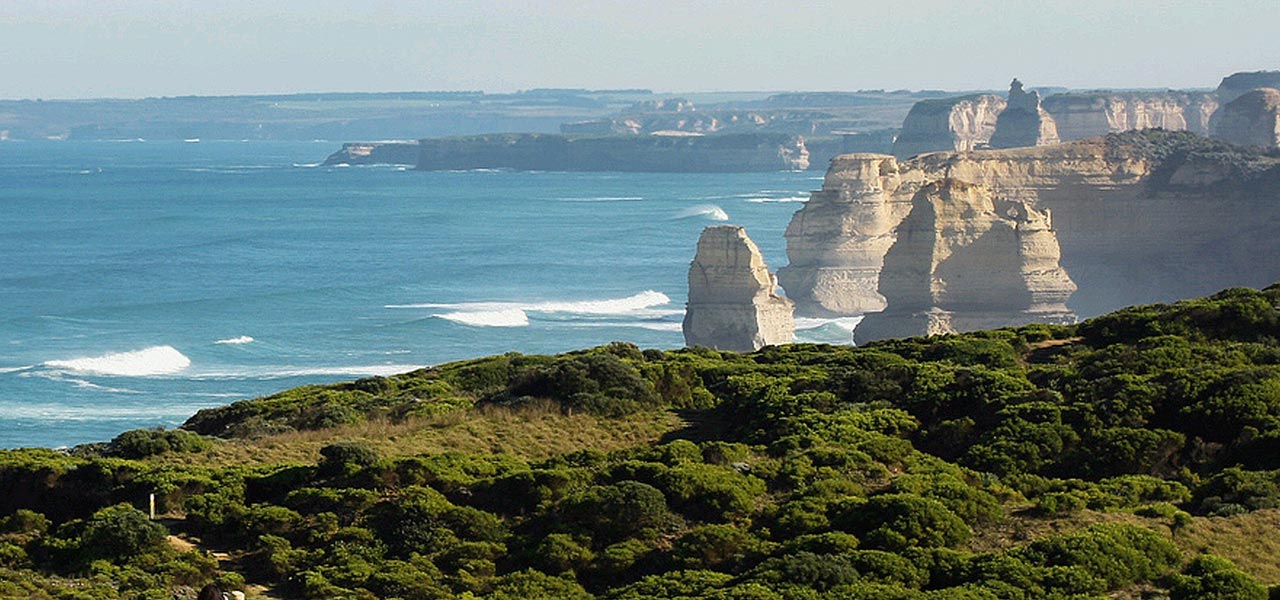Melbourne - Adelaide
Traveling from Melbourne to Adelaide along the coastline is a breathtaking 1,200 kilometer journey. This trip will take you along the "Great Ocean Road" and through the iconic surf spots of Torquay and Bells Beach, then to the vacation spot of Apollo Bay, and finally to the magnificent Twelve Apostles.
Take a walk through the waterfalls and lush forest of Otway National Park, and whale watching from Warrnambool. Soak up the maritime history of Port Fairy and Portland, near the towering cliffs of Cape Bridgewater. You will not miss the Grampians National Park as well as a wine tasting in Coonawarra. You pass through the caves of Naracoorte, classified as a UNESCO World Heritage Site.
Your journey then takes you to Kangoroo Island, which you can explore by motorhome, and finally to the vineyards of the Fleurieu Peninsula on your way to Adelaide.
Price for a motorhome for two people. Spot with electricity.
Take a walk through the waterfalls and lush forest of Otway National Park, and whale watching from Warrnambool. Soak up the maritime history of Port Fairy and Portland, near the towering cliffs of Cape Bridgewater. You will not miss the Grampians National Park as well as a wine tasting in Coonawarra. You pass through the caves of Naracoorte, classified as a UNESCO World Heritage Site.
Your journey then takes you to Kangoroo Island, which you can explore by motorhome, and finally to the vineyards of the Fleurieu Peninsula on your way to Adelaide.
Price for a motorhome for two people. Spot with electricity.
*Photos tourism Australia
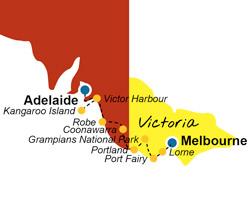
Map

Stage 1: Melbourne
Located on the Yarra River in Port Phillip Bay, Melbourne is a stylish and elegant city. It is a labyrinth of small hidden alleys, bars, exclusive restaurants and small shops.
Visit “Federation Square”, the city's historic cultural center, quench your thirst on St Kilda's promenade with a beer as the sun sets.
Shop or window shop on funky Brunswick Street or on luxurious Chapel Street.
Stroll through the cafes, bistros and bars of Southbank and tour the world of cuisine, passing by Carlton, Richmond and Fitzroy.
Be sure to take an Aboriginal heritage tour through the "Royal Botanic Gardens", or why not experience a cricket match at the Melbourne Cricket Ground.
Camping:
Melbourne Big 4 Holiday Park: Electrically powered from $ 54 per night.
Visit “Federation Square”, the city's historic cultural center, quench your thirst on St Kilda's promenade with a beer as the sun sets.
Shop or window shop on funky Brunswick Street or on luxurious Chapel Street.
Stroll through the cafes, bistros and bars of Southbank and tour the world of cuisine, passing by Carlton, Richmond and Fitzroy.
Be sure to take an Aboriginal heritage tour through the "Royal Botanic Gardens", or why not experience a cricket match at the Melbourne Cricket Ground.
Camping:
Melbourne Big 4 Holiday Park: Electrically powered from $ 54 per night.
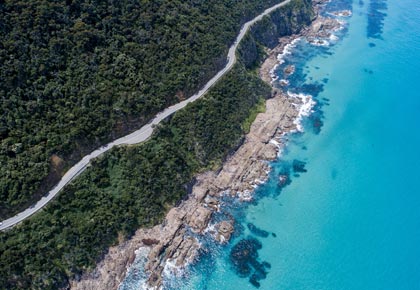
Stage 2: Melbourne � Lorne
Pass by Geelong, located on the Bellarine Peninsula, where you can walk along the waterfront,
visit the vineyards or swim in the ocean.
Continue to Torquay where the spectacular "Great Ocean Road" begins. Torquay is also the gateway to the Victoria surf area.
Visit the huge Surf Museum and then go surf the famous waves of Jan Juc or the iconic Bells Beach. You can also surf at Point Addis and Anglesea where golfers share the golf course with kangaroos.
The big waves continue to Fairhaven and "Eastern View" en route to the seaside town of Lorne.
Stop at the golden beach of Loutit Bay, or hike up to the “Erskine Falls” waterfalls, located in the Otway Ranges. Lorne is the seaside resort that has it all.
Camping:
Lorne Foreshore Caravan Park: Powered from $ 45 per night
visit the vineyards or swim in the ocean.
Continue to Torquay where the spectacular "Great Ocean Road" begins. Torquay is also the gateway to the Victoria surf area.
Visit the huge Surf Museum and then go surf the famous waves of Jan Juc or the iconic Bells Beach. You can also surf at Point Addis and Anglesea where golfers share the golf course with kangaroos.
The big waves continue to Fairhaven and "Eastern View" en route to the seaside town of Lorne.
Stop at the golden beach of Loutit Bay, or hike up to the “Erskine Falls” waterfalls, located in the Otway Ranges. Lorne is the seaside resort that has it all.
Camping:
Lorne Foreshore Caravan Park: Powered from $ 45 per night
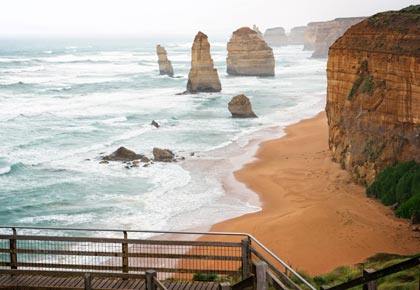
Stage 3: Lorne � Port Fairy
On the road to Apollo Bay, on one side you pass along cliffs that plunge dramatically into the ocean, and on the other you drive on the edge of the national park.
Explore the ancient forests, glowworm caves and waterfalls of the Great Otway National Park.
Visit the old lighthouse at Cape Otway and at noon prepare a picnic at "Paradise" or "Shelly Beach".
In the distance, following the undulations of the road, you will see the craggy limestone towers of the Twelve Apostles rising out of the Southern Ocean.
Take photos of the boardwalk or 'Gibson Steps', then stroll the 'London Bridge', 'Bay of Islands' and 'Loch Ard Gorge' trails.
Continue along the 'Shipwreck Coast', named after the stormy seas that sent at least 700 ships crashing into the rocks.
Stop at Warrnambool (Logan Beach), where from May to October the whales come your way.
Soak up the maritime history of Port Fairy, with its old whitewashed houses and Georgian-style houses. You can also go see Australia's largest fur seal colony as well as dolphins, whales and sharks.
Camping:
Port Fairy Big 4: With electricity from $ 44 per night
Explore the ancient forests, glowworm caves and waterfalls of the Great Otway National Park.
Visit the old lighthouse at Cape Otway and at noon prepare a picnic at "Paradise" or "Shelly Beach".
In the distance, following the undulations of the road, you will see the craggy limestone towers of the Twelve Apostles rising out of the Southern Ocean.
Take photos of the boardwalk or 'Gibson Steps', then stroll the 'London Bridge', 'Bay of Islands' and 'Loch Ard Gorge' trails.
Continue along the 'Shipwreck Coast', named after the stormy seas that sent at least 700 ships crashing into the rocks.
Stop at Warrnambool (Logan Beach), where from May to October the whales come your way.
Soak up the maritime history of Port Fairy, with its old whitewashed houses and Georgian-style houses. You can also go see Australia's largest fur seal colony as well as dolphins, whales and sharks.
Camping:
Port Fairy Big 4: With electricity from $ 44 per night
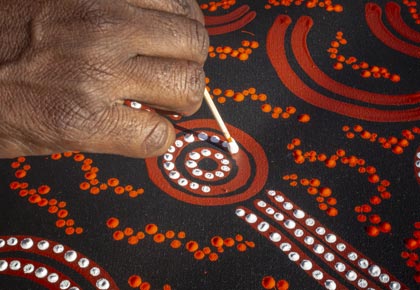
Stage 4: Port Fairy � Grampians National Park
Today you step inland so you don't miss the famous "Grampians National Park". Discover the rock art and rugged landscapes of a mountain range as old as time.
The Grampians is a majestic range of mountains and forest overlooking the farmlands of western Victoria. This national park is home to a huge variety of native plants and animals and a rich Aboriginal history.
Most of Victoria's Aboriginal sites are here in the Grampians, known as Gariwerd by Aboriginal clans linked to this place for over 22,000 years. Evidence of their life, the ancient kiln mounds and 60 rock art sites with more than 4,000 different motifs, are scattered across the region.
Visit the famous Bunjil refuge and see Bunjil, the traditional creator of the land, represented with his two dingoes. Gulgurn Manja translates to "hands of the young," and this refuge in the North Grampians is covered in small red ocher handprints. You can also browse the Grampians Cultural Center or take a guided tour of Halls Gap to learn about the five Aboriginal communities in the Victoria region.
Intertwined with this history, the awe-inspiring landscapes were forged millions of years ago. You can hike along the sheer cliffs and waterfalls of the Grampians National Park. Go fishing or canoeing on Lake Bellfield and Lake Wartook, and see the country's animals up close, such as koalas, kangaroos, emus and tailed eagles.
Then head to Mount Arapiles-Tooan State Park, where you can appreciate the spectacular rock formations. A little further away is the small Desert National Park where wildflowers abound from August to October. Then, if you still have time, explore the vast sandstone mountains by 4x4 or with a flyover.
Camping:
BIG4 NRMA Halls Gap Holiday Park: Powered from $ 34 per night
The Grampians is a majestic range of mountains and forest overlooking the farmlands of western Victoria. This national park is home to a huge variety of native plants and animals and a rich Aboriginal history.
Most of Victoria's Aboriginal sites are here in the Grampians, known as Gariwerd by Aboriginal clans linked to this place for over 22,000 years. Evidence of their life, the ancient kiln mounds and 60 rock art sites with more than 4,000 different motifs, are scattered across the region.
Visit the famous Bunjil refuge and see Bunjil, the traditional creator of the land, represented with his two dingoes. Gulgurn Manja translates to "hands of the young," and this refuge in the North Grampians is covered in small red ocher handprints. You can also browse the Grampians Cultural Center or take a guided tour of Halls Gap to learn about the five Aboriginal communities in the Victoria region.
Intertwined with this history, the awe-inspiring landscapes were forged millions of years ago. You can hike along the sheer cliffs and waterfalls of the Grampians National Park. Go fishing or canoeing on Lake Bellfield and Lake Wartook, and see the country's animals up close, such as koalas, kangaroos, emus and tailed eagles.
Then head to Mount Arapiles-Tooan State Park, where you can appreciate the spectacular rock formations. A little further away is the small Desert National Park where wildflowers abound from August to October. Then, if you still have time, explore the vast sandstone mountains by 4x4 or with a flyover.
Camping:
BIG4 NRMA Halls Gap Holiday Park: Powered from $ 34 per night
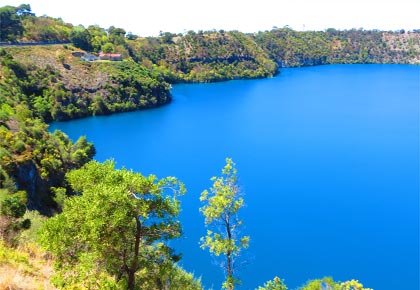
Stage 5: Grampians National Park - Portland � Coonawarra
It's time to head back along the coast to Portland, which was Victoria's first European settlement. Discover hundreds of historic buildings, and watch the fishing boats landing with their catches on the docks. Continue this beautiful coastal drive to "Cape Nelson State Park" and the towering cliffs of "Cape Bridgewater". Here you can explore the petrified sand forest and walk around the cape to see the large colony of fur seals.
Back on the main road, cross Nelson and the South Australian border. Visit Mount Gambier, which sits on a former extinct volcano, and is now surrounded by lakes, like Lac Bleu, so named for its vivid color that it takes from November to February. Continue north to Penola, then stop at Coonawarra where you can taste their superb Cabernet Sauvignon in the local cellars.
Camping:
Penola Caravan Park: With electricity from $ 34 per night
Back on the main road, cross Nelson and the South Australian border. Visit Mount Gambier, which sits on a former extinct volcano, and is now surrounded by lakes, like Lac Bleu, so named for its vivid color that it takes from November to February. Continue north to Penola, then stop at Coonawarra where you can taste their superb Cabernet Sauvignon in the local cellars.
Camping:
Penola Caravan Park: With electricity from $ 34 per night
If you have any questions about your trip in Australia
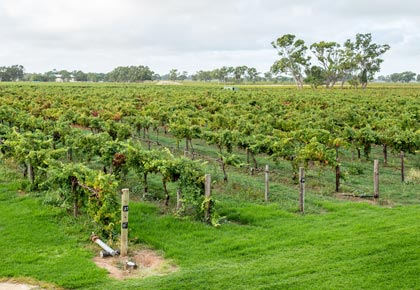
Stage 6: Coonawarra et ses alentours, le parc national des grottes de Naracoorte
Coonawarra is recognized as one of Australia's finest wine regions, and is particularly known for the production of world-class red wines, especially Cabernet Sauvignon. Its secret lies in a magical marriage of rich red from the "terra rossa" soil, limestone, pure groundwater and a long period of maturation in a cool climate for the grapes.
Today, Coonawarra wines are the region’s red gold. The cigar-shaped strip of "terra rossa" is 21 kilometers long by 2 kilometers wide, and all this area is reserved for vineyards. Over 25 wineries have their own cellars and outlets, most open seven days a week (except Christmas Day), and you will be warmly welcomed for tastings.
On the other hand, before strolling around, glass in hand, set off to explore Naracoorte National Park. Not only will the beauty of the Naracoorte caves leave you speechless, but the history of the fossils present is very intriguing. These fossils have enabled the Naracoorte Caves National Park to be included in the UNESCO World Heritage List.
For more than 500,000 years, giant animals roamed the region of Naracoorte. Fallen into these huge, well-hidden ditches, their fossilized skeletons are still present, giving scientists a rare glimpse of animal life that was extinct long ago.
Giant marsupials like the wombat Diprotodon, Thylacoleo (marsupial lion) and giant kangaroos lived in the area. These animals, along with many others, were recreated in life-size models at the Wonambi Fossil Center.
The 26 caves of the park also offer a fabulous spectacle of stalagmites and stalactites. There are plenty of tours on offer, showcasing the amazing fossils and limestone formations. If you are into adventure caving, go crawl, slide and squeeze through the tunnels and chambers of these caves.
Camping:
Big 4 Naracoorte Holiday Park: With electricity from $ 35 per night
Today, Coonawarra wines are the region’s red gold. The cigar-shaped strip of "terra rossa" is 21 kilometers long by 2 kilometers wide, and all this area is reserved for vineyards. Over 25 wineries have their own cellars and outlets, most open seven days a week (except Christmas Day), and you will be warmly welcomed for tastings.
On the other hand, before strolling around, glass in hand, set off to explore Naracoorte National Park. Not only will the beauty of the Naracoorte caves leave you speechless, but the history of the fossils present is very intriguing. These fossils have enabled the Naracoorte Caves National Park to be included in the UNESCO World Heritage List.
For more than 500,000 years, giant animals roamed the region of Naracoorte. Fallen into these huge, well-hidden ditches, their fossilized skeletons are still present, giving scientists a rare glimpse of animal life that was extinct long ago.
Giant marsupials like the wombat Diprotodon, Thylacoleo (marsupial lion) and giant kangaroos lived in the area. These animals, along with many others, were recreated in life-size models at the Wonambi Fossil Center.
The 26 caves of the park also offer a fabulous spectacle of stalagmites and stalactites. There are plenty of tours on offer, showcasing the amazing fossils and limestone formations. If you are into adventure caving, go crawl, slide and squeeze through the tunnels and chambers of these caves.
Camping:
Big 4 Naracoorte Holiday Park: With electricity from $ 35 per night
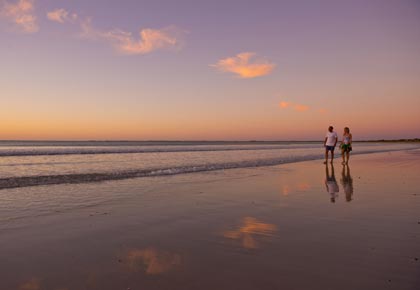
Stage 7: Coonawarra � Robe � Victor Harbor
You descend to Robe to take the magnificent road along the seaside. You arrive in Robe with its charming sheltered port. Robe is a small, picturesque fishing village with a superb seventeen kilometer long "Long Beach" beach. It is located just outside the town north of Robe.
Continue north and pass through Kingston South East, where you can visit the historic Cape Jaffa Lighthouse. Canoe or kayak along the shallow lagoons of Coorong, and admire the rich diversity of birds.
Cross the Murray River in Wellington, and continue to Strathalbyn, then to the Langhorne Creek wine country and historic Goolwa river port.
In Middleton, you can surf, fly kites and see southern whales between June and September. Stop at Boomer Beach in Port Elliot, before arriving in Victor Harbor.
Camping:
Victor Harbor Beachfront Holiday Park: Powered from $ 33 per night
Continue north and pass through Kingston South East, where you can visit the historic Cape Jaffa Lighthouse. Canoe or kayak along the shallow lagoons of Coorong, and admire the rich diversity of birds.
Cross the Murray River in Wellington, and continue to Strathalbyn, then to the Langhorne Creek wine country and historic Goolwa river port.
In Middleton, you can surf, fly kites and see southern whales between June and September. Stop at Boomer Beach in Port Elliot, before arriving in Victor Harbor.
Camping:
Victor Harbor Beachfront Holiday Park: Powered from $ 33 per night
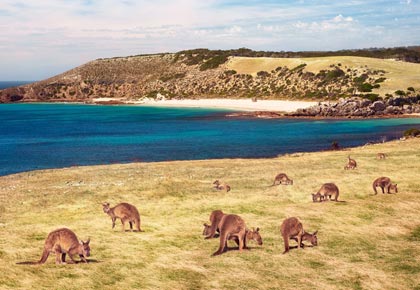
Stage 8: Kangaroo Island
Today, departure for Kangaroo Island. You can take your motorhome on the ferry, and you will find campsites on the island.
Kangaroo Island is a zoo without fences. Kangaroos, koalas, wallabies, penguins, echidnas and birds all live together on the island. Seal Bay is the only place in Australia where you can walk the beach among a colony of endangered Australian sea lions.
With all of this wildlife and natural beauty, you might think Kangaroo Island is only the home of animals.
However, although the resident population does not exceed 4,500 people, this island is the cradle of many stories about the population of the country: between the convicts who found refuge there and the first free colony of Australia, it is a place with a history like nowhere else in Australia. Today, Kangaroo Island gives way to farmers, winegrowers, artists, chefs, ...
Steep cliffs, sheltered bays between headlands, large plains and rolling hills of farmland are just some of the landscapes of the island. The “Remarkable Rocks” and the “Admirals Arch” are arguably Australia's two most fascinating coastal sites. Not to be missed!
Camping:
Kingscote Tourist Park: With electricity from $ 31 per night
Western KI Caravan Park: With electricity from $ 35 per night
Kangaroo Island is a zoo without fences. Kangaroos, koalas, wallabies, penguins, echidnas and birds all live together on the island. Seal Bay is the only place in Australia where you can walk the beach among a colony of endangered Australian sea lions.
With all of this wildlife and natural beauty, you might think Kangaroo Island is only the home of animals.
However, although the resident population does not exceed 4,500 people, this island is the cradle of many stories about the population of the country: between the convicts who found refuge there and the first free colony of Australia, it is a place with a history like nowhere else in Australia. Today, Kangaroo Island gives way to farmers, winegrowers, artists, chefs, ...
Steep cliffs, sheltered bays between headlands, large plains and rolling hills of farmland are just some of the landscapes of the island. The “Remarkable Rocks” and the “Admirals Arch” are arguably Australia's two most fascinating coastal sites. Not to be missed!
Camping:
Kingscote Tourist Park: With electricity from $ 31 per night
Western KI Caravan Park: With electricity from $ 35 per night
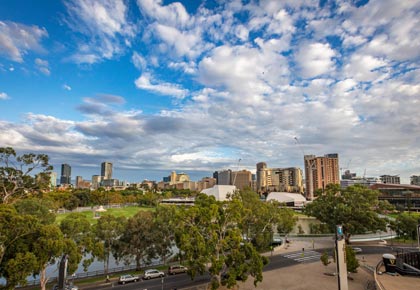
Stage 9: Kangaroo Island - Adelaide
You arrive at the end of your journey and at your final destination. Before returning your motorhome to Adelaide, pass by the attractions of the Fleurieu Peninsula. Take the streetcar to Granite Island to see razorbills or watch whales between June and October at Encounter Bay.
Take a part of the Heysen hike along the coast of Deep Creek Conservation Park. Continue along the golf course of St Vincent, and stop for a quick dip at the beaches of Sellicks and Aldinga. Or drive through the verdant hills of Mount Compass and Yankalilla in the McLaren Vale wine country.
Visit the galleries and taste the many wines from the 45 vineyards in this region. Stock up on olives, oils, cheeses, almonds and roadside berries before arriving in Adelaide.
Once in Adelaide, take a stroll on North Terrace Boulevard on foot, or in the large parks, and enjoy the seaside atmosphere of Glenelg and Henley
Camping:
Adelaide Caravan Park: Powered from $ 44 per night
Take a part of the Heysen hike along the coast of Deep Creek Conservation Park. Continue along the golf course of St Vincent, and stop for a quick dip at the beaches of Sellicks and Aldinga. Or drive through the verdant hills of Mount Compass and Yankalilla in the McLaren Vale wine country.
Visit the galleries and taste the many wines from the 45 vineyards in this region. Stock up on olives, oils, cheeses, almonds and roadside berries before arriving in Adelaide.
Once in Adelaide, take a stroll on North Terrace Boulevard on foot, or in the large parks, and enjoy the seaside atmosphere of Glenelg and Henley
Camping:
Adelaide Caravan Park: Powered from $ 44 per night



